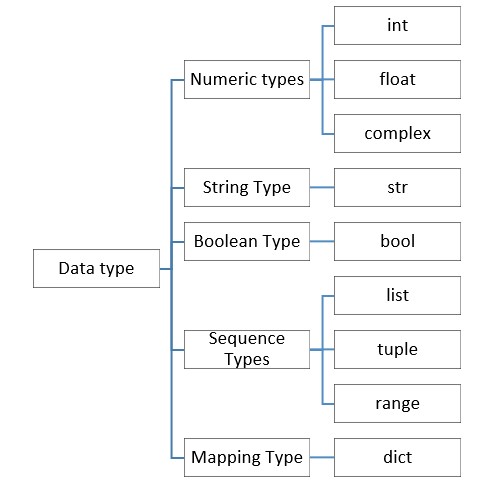Variables and Types
When we create a program, we often like to store values so that it can be used later. Programs use variables to access and manipulate data that is stored in memory. A variable is a name that represents a value in the computer’s memory.
Let's take an example to understand this better. The following program uses variables to hold data:
Program (sum-two-numbers.py)
a = 10
b = 15
c = a + b
print("Sum of numbers are", c)The above code defines three variables: a, b, and c. The first line sets the value of a to 10, and the second line sets the value of b to 15.
The third line calculates the sum of a and b by using the + operator, and assigns the result to c.
Finally, the print() function is used to display the message "Sum of numbers are" followed by the value of c.
After running the code, the output will be displayed in the console, which should be:
Sum of numbers are 25
Creating Variables
In python, variable is created when we assign value to it. In following code fragment two variables a and b are created.
a = 10
b = 15
Creating Multiple Variables in single statement with different values
x, y, z = "Orange", "Banana", "Apple"Creating Multiple Variables in single statement with same values
x = y = z = "Orange"Data Type
In Python, the datatype of a variable is determined dynamically at runtime, based on the value assigned to it. This means that you do not need to declare the datatype of a variable before assigning a value to it. Python automatically assigns the appropriate datatype based on the value you provide.
For example, if you assign an integer value to a variable, Python will assign the datatype "int" to that variable. If you assign a string value, Python will assign the datatype "str" to the variable. Similarly, if you assign a floating-point number, Python will assign the datatype "float" to the variable.
Examples:
x = 10 # int
y = 3.14 # float
z = "Hello" # strYou can check the datatype of a variable using the type() function. For example:
x = 10
print(type(x)) # Output: <class 'int'>
y = 3.14
print(type(y)) # Output: <class 'float'>
z = "Hello"
print(type(z)) # Output: <class 'str'>In Python, there are several built-in datatypes, including:

When you perform operations on variables, Python will automatically convert the datatypes if necessary. For example, if you add an integer and a float, Python will convert the integer to a float before performing the addition:
x = 10 # int
y = 3.14 # float
z = x + y # float
print(z) # Output: 13.14In summary, Python dynamically determines the datatype of a variable based on the value assigned to it, and you can check the datatype using the type() function.
Naming Rule of Variable
To name variables in Python, you must follow these rules:
- A variable name can be of any size
- A variable name have allowed characters, which are a-z, A-Z, 0-9 and underscore (_)
- A variable name should begin with an alphabet or underscore
- A variable name should not be a keyword
- A variable name cannot contain spaces.
- Uppercase and lowercase characters are distinct.
Here are some examples of valid and invalid variable names in Python:
Valid variable names:
age = 25 name = "John" email_address = "john@example.com" total_sales = 500.50 first_name = "Mary"
Invalid variable names:
2nd_grade = 80 # cannot start with a number first-name = "John" # cannot use hyphens total/sales = 500 # cannot use forward slash email address = "john@example.com" # cannot use spaces if = 10 # cannot use Python keywords as variable names
Keywords
There are some reserved words in Python which have predefined meaning called keywords. These words may not be used as variable name. Some commonly used Keywords are given below:
| and | del | from | not | while |
| as | elif | global | or | with |
| assert | else | if | pass | yield |
| break | except | import | ||
| class | exec | in | raise | |
| continue | finally | is | return | |
| def | for | lambda | try |